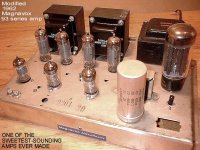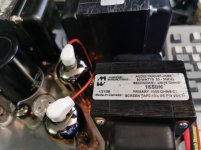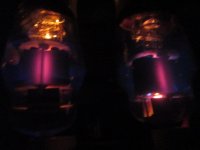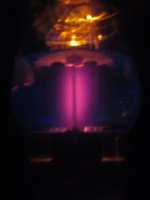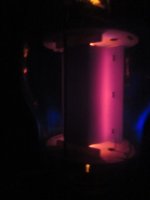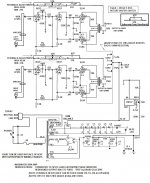! https://sep.yimg.com/ay/triodeel/z5...put-transformer-for-dynaco-made-in-usa-14.gif
I was going to celebrate Transcendar’s abilty to duplicate Dynaco Z565 transformer if indeed they could. But was rudely interupted by partisan blah-blah. Moderator, please do your job.
https://sep.yimg.com/ay/triodeel/z5...put-transformer-for-dynaco-made-in-usa-14.gif These transformers may be also a great deal.
I was going to celebrate Transcendar’s abilty to duplicate Dynaco Z565 transformer if indeed they could. But was rudely interupted by partisan blah-blah. Moderator, please do your job.
https://sep.yimg.com/ay/triodeel/z5...put-transformer-for-dynaco-made-in-usa-14.gif These transformers may be also a great deal.
Do you comprehend the difference between cheaply made and cheap (and quirky) ? I am aware that British stuff was and is very expensive for what it is materially but it sounds good enough. It is fortunate that the audio development was taxpayer paid but the taxpayer had to pay a lot to enjoy the fruit of the development.
Please, please, stop this non-sense bickering and get back to the OP question asked.
! https://sep.yimg.com/ay/triodeel/z5...put-transformer-for-dynaco-made-in-usa-14.gif
I was going to celebrate Transcendar’s abilty to duplicate Dynaco Z565 transformer if indeed they could.
Has anyone tried these Transcendar copies of the famous Dynaco z565 output transformers. It would be really good to hear some first hand experiences. I hope we have a secondaty source of those great transformers.
Years ago, as I was building my EL84 stereo amp, I carefully did my homework for suitable output transformers.
I didn't go into messing around with opinions, and I wanted a transformer that naturally performed with as pure and undistorted output as possible.
I checked out the "transformer shootout" details on Triode's site - http://triodeel.com/pdf/xfmrshootout.pdf
I also went over other sites relating to the use of these transformers, including David Gillespie's biasing idea - the "EFB" system. - New Modifications for the Dynaco SCA35 and ST-35
After testing several transformers for EL84's, I settled on the Dynaco Z565 in ultralinear duty, along with Gillespie's Enhanced Fixed Bias system.
No opinions from others, no endless babbling from internet blogs, I wound up with a near-perfect amplifier that drives my hungry floor-standing Advent Maestro's (4 ohms) with ease and grace.
The original chassis, taken from a console Magnavox 9304 amp chassis was the base, and now competes with EL84 amps costing rediculous prices.
The bottom line - I'm quite pleased with the results, I haven't had ANY problems with the amp since 2007.
I didn't go into messing around with opinions, and I wanted a transformer that naturally performed with as pure and undistorted output as possible.
I checked out the "transformer shootout" details on Triode's site - http://triodeel.com/pdf/xfmrshootout.pdf
I also went over other sites relating to the use of these transformers, including David Gillespie's biasing idea - the "EFB" system. - New Modifications for the Dynaco SCA35 and ST-35
After testing several transformers for EL84's, I settled on the Dynaco Z565 in ultralinear duty, along with Gillespie's Enhanced Fixed Bias system.
No opinions from others, no endless babbling from internet blogs, I wound up with a near-perfect amplifier that drives my hungry floor-standing Advent Maestro's (4 ohms) with ease and grace.
The original chassis, taken from a console Magnavox 9304 amp chassis was the base, and now competes with EL84 amps costing rediculous prices.
The bottom line - I'm quite pleased with the results, I haven't had ANY problems with the amp since 2007.
Attachments
Last edited:
No, but what is against using todays material like C-core outputs? You can order them anywhere from €150,- to 200,- the pair. Flat response, high BW and poured in a nice 10x10cm cube.
Please, please, stop this non-sense bickering and get back to the OP question asked.
The copies of the of the Dyna trans are available for many years now. What's to celebrate?
Good measuring transformers and good sounding transformer are two different things .
The OP already indicated that anything more expensive than free is too expensive which is what 90% of DIY posters here want.
The only qualified for posting should be those who heard Leak amps. DID YOU ?? I restored leak TL50 plus monos and Stereo 20 and know how they sound with modern and vintage speakers they supposed to be working with.
If he can spend the money on original Leak and he can spend money on Tannoy Red than yes it's a nice combination. Nothing else is going to sound like Leak but Leak with original transformer. I'm sure someone can wind a copy of a leak OPT.
Last edited:
After testing several transformers for EL84's, I settled on the Dynaco Z565 in ultralinear duty, along with Gillespie's Enhanced Fixed Bias system.
No opinions from others, no endless babbling from internet blogs, .
Says it all really doesn't it?
Z565
020Hz 10.50V +21.7dB 3.43%THD+N 13.81W @ 8ohm
magnequest
020Hz 10.58V +21.8dB 3.570%THD+N 13.97W @ 8ohm
All others massive signs of saturation.....hammonds
020Hz 9.910V +21.2dB 10.08%THD+
020Hz 09.27V +20.6dB 16.18%THD+N 10.65W @ 8ohm
Gillespie a great bloke talking lots of common sense.
Hammond PP transformers are rated for 30Hz to 30kHz FYI...
Attachments
Last edited:
The copies of the of the Dyna trans are available for many years now. What's to celebrate?
<snip>
The OP already indicated that anything more expensive than free is too expensive which is what 90% of DIY posters here want.
There is nothing wrong with c-core, or Amorphous cores, and the quest is for the best bang for the buck.
It would indeed be cause for celebration if those Z565 transformers are available from multiple sources at reasonable prices. I believe tube folks are willing to pay reasonable prices, but there is nothing wrong with looking for the best deal at current conditions.
Thanks 6vheater for the test results. Are those figures you have measured, or is there a source that could be referenced?
Last edited:
Says it all really doesn't it?
Z565
020Hz 10.50V +21.7dB 3.43%THD+N 13.81W @ 8ohm
magnequest
020Hz 10.58V +21.8dB 3.570%THD+N 13.97W @ 8ohm
All others massive signs of saturation.....hammonds
020Hz 9.910V +21.2dB 10.08%THD+
020Hz 09.27V +20.6dB 16.18%THD+N 10.65W @ 8ohm
Gillespie a great bloke talking lots of common sense.
What really tells all is the listening experience with those Z565s.
Silky smooth, crystal clear, non fatiguing sonics from bass drums to trumpets.
Those are published from a shootout with triodeel. (you can find online)Thanks 6vheater for the test results. Are those figures you have measured, or is there a source that could be referenced?
I have a somewhat different way of doing my own tests, which I am not sure anyone ever does.
It's remarkably simple, which is why I don't know why nobody has ever done it before.
The output to the amp under test comes from a high quality studio sound card with known characteristics (so D-A)...the amp has the dummy load across the output as per usual, then a resistive divider across that, say 110k>10K to drop the massive output voltage by 10.
That means we cannot overload the input even with 30V out into 10 ohms (90W), so we can't get false readings because of clipping, that's fed back into the card input A>D.
A loop back from A>D O/P>I/P in one channel provides the reference levels and a trace of what should be coming back and at what level, so you can't cheat.
What you see is what you get.
The program "soundcard scope" displays the output from the 2 input channels just like a scope does, so you can compare them directly ONE superimposed at whatever scale you like over the other.
A sound recorder program (I often use Steinberg) records all the results.
If you wish to check the IMD you can run IMD test tones, and watch the results in real time on FFT, as you wind the levels up and down.
You also record the outputs, then play them back (eg 24-96) into a distortion meter.
I use an old HP for continuous tones.
You don't have to run the amp any more for that because you have recorded the output already and if you are smart you set up standard sequences to automate or batch record the processes.
It's then possible to analyse phase, distortion, clipping,square wave reponses and all at any later date you care to choose.
TBQH, evidence of clipping, and other nasties are so clear and obvious in this system it's a real no-brainer, and the levels are accurate to 0.1dB
I thought you might like to know that.
Professional computer DAW are powerful tools.
In a recent mic shoot out done for a mnufacturer we actually managed to work out and visualise distortion in Neumann microphones v xx maker which I could not imagine existed. (I assumed it was the amp or the speaker).
The interesting thing, the speaker and amp were found by elimination to be perfectly linear, but I had assumed all along were a source of distortion.
It was the biggest suprise of my life to discover LF distortion in high quality studio mics, as well as seeing so many very expensive DACs keel over and demonstrate horrific problems under square wave source material.
We do quite a lot of validation work, and there are such big suprises testing modern valve amps, I've got to the point I don't want t do it any more for fear of blowing them up or melting them...
This is an example of an amp under FULL square wave load at 80W.
In my book, if an amp can't stand this sort of test for 10mins, then it's probably not a lot of good.
Most of the modern ones I tested simply looked melting within 5 secs...🙄
Attachments
Surely you'd lose that bet. The Hiwatt DR400 is a guitar ampilfier with a tone stack that simply can't be set for linear frequency response. Let alone the non linear NFB loop including the Presence control.I wouldn't mind betting you could drop a 1970s DR400 into a hifi system direct tomorrow, it would sound better than 99% of what is being sold today, and probably melt the speakers too.
Anyway, due to the superb quality of the Partridge OT, you could use the DR 400's complete PSU, the set of (6) KT88's and the OT, select a suitable driver circuitry and build a very good power amplifier.
Best regards!
Years ago, as I was building my EL84 stereo amp, I carefully did my homework for suitable output transformers.
I didn't go into messing around with opinions, and I wanted a transformer that naturally performed with as pure and undistorted output as possible.
I checked out the "transformer shootout" details on Triode's site - http://triodeel.com/pdf/xfmrshootout.pdf
I also went over other sites relating to the use of these transformers, including David Gillespie's biasing idea - the "EFB" system. - New Modifications for the Dynaco SCA35 and ST-35
After testing several transformers for EL84's, I settled on the Dynaco Z565 in ultralinear duty, along with Gillespie's Enhanced Fixed Bias system.
No opinions from others, no endless babbling from internet blogs, I wound up with a near-perfect amplifier that drives my hungry floor-standing Advent Maestro's (4 ohms) with ease and grace.
The original chassis, taken from a console Magnavox 9304 amp chassis was the base, and now competes with EL84 amps costing rediculous prices.
The bottom line - I'm quite pleased with the results, I haven't had ANY problems with the amp since 2007.
Is the schematic for your amp available?
Is the schematic for your amp available?
Sure thing.. 😀
If you must use any other power transformer, make sure it gives close to 300-325V DC for the B+ to the outputs.
This is the schematic, and although it's using 6EU7 preamp/phase inverters, you can use 12AX7's with the appropiate wiring changes.
I chose the 6EU7's for their very good immunity to noise.
If built to my design, it's a terrific amp.
Also, if you don't need to fool with the "variable feedback", you can simply use just a 27K resistor instead.
If you build it, let me know what you think.
Attachments
Last edited:
Thanks for posting this schematic. It is exactly what I have been looking for. I have come to many of the same conclusions in my studies for what features to use.
-david BTW
-david BTW
Hello
when it comes to good and not too expensive speaker transformers, I recommend trying out EDIS Ogonowski from Poland ... I use them and most people from my country ... they are wound on order from the manufacturer Mr. Leszek but also available from one of the largest accessories stores tube lampy elektronowe.pl. The quality is great, these are professional transformers. As for the company Toroidy .pl .. so it is a big company with us in Poland but their speaker transformers are not considered good by us just when measuring comes out the sound is much worse than with classic shaped transformers, while as power supplies they are great 😉
when it comes to good and not too expensive speaker transformers, I recommend trying out EDIS Ogonowski from Poland ... I use them and most people from my country ... they are wound on order from the manufacturer Mr. Leszek but also available from one of the largest accessories stores tube lampy elektronowe.pl. The quality is great, these are professional transformers. As for the company Toroidy .pl .. so it is a big company with us in Poland but their speaker transformers are not considered good by us just when measuring comes out the sound is much worse than with classic shaped transformers, while as power supplies they are great 😉
Hello Front247,
Thank you for posting your assessment and experience with Toroidy and Ogonowski transformers in Poland. If the latter is better than Toroidy they must be very good.
Thank you for posting your assessment and experience with Toroidy and Ogonowski transformers in Poland. If the latter is better than Toroidy they must be very good.
@wiseoldtech thanks for posting your schematic - it is a nice design. I particularly like the EL84 baising/cathode arrangement.Is the schematic for your amp available?
For my own edification, I wanted to ask a few questions about the preamp/phase splitter stages. Why do they have a common cathode resistor? With the phase splitter, isn't there some imbalance becasue on the anode you have 120k, while on the cathode 123.7k? I know it's a small difference, but still.
The 1M grid resisitor of the phase splitter triode doesn't go to ground, but to the top of the lower ressitor - isn't that then feeding back the output into the grid of the triode - positive feedback?
@wiseoldtech thanks for posting your schematic - it is a nice design. I particularly like the EL84 baising/cathode arrangement.
For my own edification, I wanted to ask a few questions about the preamp/phase splitter stages. Why do they have a common cathode resistor? With the phase splitter, isn't there some imbalance becasue on the anode you have 120k, while on the cathode 123.7k? I know it's a small difference, but still.
The 1M grid resisitor of the phase splitter triode doesn't go to ground, but to the top of the lower ressitor - isn't that then feeding back the output into the grid of the triode - positive feedback?
Ahh, the questions!
To put it simply, the biasing arrangement and feedback design is from a long-gone great designer of audio equipment, a bit unconventional, since you must have in your mind that the 1 meg resistor "must' go to ground.
In this case, its use is also to hold a steady biasing of the phase invertor regardless of drive conditions - resulting in a cleaner and more balanced drive to the outputs.
The small "deviation" you mentioned about the lower resistances is also a controlled "system" allowing some local feedback to the preamp.
All that, and along with the novel output biasing arrangement, results in a highly stable amplifier under even stressful conditions - distortion is difficult to get even when pushed hard.
My neighbor, with his "picky ears" cannot tell the difference between this tube amp, and the 60W/ch SS amp when I "A/B" switch between them.
Even at louder than normal listening levels - driving the Advent Maestro floor speakers.
I've used this tested and reliable design on other amp builds, all perform excellently.
When you get something "right" as this amp design shows me, you stick with it.
Ahh, the questions!
To put it simply, the biasing arrangement and feedback design is from a long-gone great designer of audio equipment, a bit unconventional, since you must have in your mind that the 1 meg resistor "must' go to ground.
In this case, its use is also to hold a steady biasing of the phase invertor regardless of drive conditions - resulting in a cleaner and more balanced drive to the outputs.
The small "deviation" you mentioned about the lower resistances is also a controlled "system" allowing some local feedback to the preamp.
All that, and along with the novel output biasing arrangement, results in a highly stable amplifier under even stressful conditions - distortion is difficult to get even when pushed hard.
My neighbor, with his "picky ears" cannot tell the difference between this tube amp, and the 60W/ch SS amp when I "A/B" switch between them.
Even at louder than normal listening levels - driving the Advent Maestro floor speakers.
I've used this tested and reliable design on other amp builds, all perform excellently.
When you get something "right" as this amp design shows me, you stick with it.
Thnaks for the answers - I am building an EL84 PP amp now, and am trying out different configurations, so will give this a bash. Will have to do some calcs because I am using an E88CC valve.
- Home
- Amplifiers
- Tubes / Valves
- Output transformer for EL84 PP
